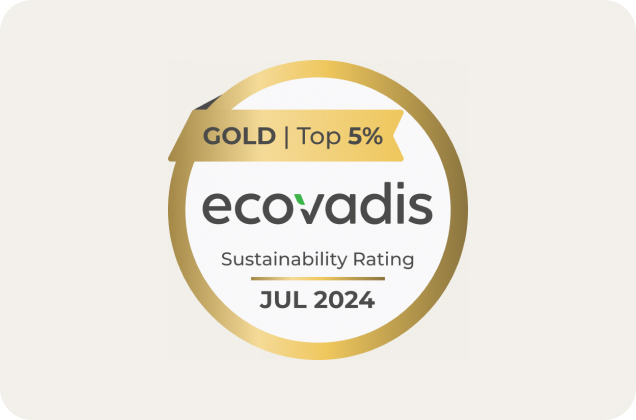Environmental pillar
The digital sector accounts for a significant share of global CO2 emissions (4%), and is steadily increasing, especially since the arrival of AI. At JEMS, we are committed to reducing our direct and indirect emissions by 50% by 2030, through a proactive decarbonization plan in line with the SBTI trajectory. Our products, services and solutions integrate a unique data industrial methodology, minimizing energy consumption and illustrating our concrete commitment to sustainable and responsible digital development.

GOLD Ecovadis label
The GOLD Ecovadis label obtained by JEMS is the result of a rigorous assessment based on four key pillars: the environment, human and social rights, ethics, and responsible purchasing. With an overall score of 73/100, JEMS demonstrates its commitment to reducing its environmental impact and improving its social and ethical practices.
I. Climate change and digital responsibility
By joining the SBTI initiative, JEMS has committed to setting clear, measurable and science-based targets to reduce its GHG emissions by 50% by 2030. This commitment represents a crucial step in our approach to environmental responsibility, and demonstrates our commitment to long-term sustainable practices.
We are a signatory to the Planet Tech’Caremanifesto at the instigation of our Numeum union. This movement commits us to measuring and reducing our environmental impact, as well as raising awareness among our employees and stakeholders.
We are joining the Institut du Numérique Responsable to obtain Level 1 certification and the Lucie label in 2025.
A) Raising awareness
We educate and train all our employees in eco-responsibility. (more than 40% already aware).
30% of employees have been made aware of climate change through the Fresque du Climat et du Numérique.
An ambitious eco-design training program has been deployed for all JEMS Group employees.
We have trained our employees in digital accessibility with our partner OPQUAST. These people work across the entire digital product value chain: marketing, UX/UI design, development and quality validation. OPQUAST is a repository of web quality best practices, including RGAA, GDPR and Ecoresponsibility.


B) Digital responsibility
Over the years, we have also developed a methodology for modeling and organizing data in order to set up reusable data assets, thereby factoring processing as far as possible and thus limiting their carbon footprint.
We are also working on assessing the climate impact of our projects.
II. Resources & Circularity
We favor the purchase of over 90% reconditioned electronics, and are committed to extending the lifespan of our equipment to over four years.
We also recover over 50% of our electronic waste by donating it to associations or recycling it.
We print all our documents on recycled paper.
All administrative processes (pay slips, orders, purchases, invoices, faxes, signed contracts, etc.) are dematerialized.
With a footprint of 1.83 tCO2e per employee in 2023 (compared with 2.1 tCO2e per employee in 2022), we aim to reduce our GHG emissions by 50% by 2030.
We are distributing mugs to all employees so that they no longer buy disposable cups, which brings together more than 400 kg of annual waste avoided since 2019.